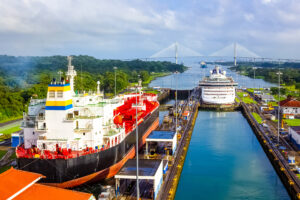 The number of vessels waiting to transit the Panama Canal has reached 161, more than double the number typically seen during the rainy season, and slots for carriers to pre-book passage are being reduced in an effort to manage the growing backlog of vessels. The current wait time for pre-registered vessels to cross the canal has topped 20 days, up from 15 days on August 1 and 1 day prior to the restrictions.
The number of vessels waiting to transit the Panama Canal has reached 161, more than double the number typically seen during the rainy season, and slots for carriers to pre-book passage are being reduced in an effort to manage the growing backlog of vessels. The current wait time for pre-registered vessels to cross the canal has topped 20 days, up from 15 days on August 1 and 1 day prior to the restrictions.
The massive traffic jam is a result of water conservation measures deployed by the Panama Canal Authority (ACP) in late July, which limited the number of daily vessel transits to 32 and required carriers to pre-book passage. According to a recent article by CNBC, only 38% of vessels waiting to cross have reservations, compelling 62% of vessels to wait in line, some for more than a month.
In an effort to ease the growing bottleneck of vessels without reservations, the ACP has reduced the number slots for Panamax vessels, the largest vessels that transit the canal, to pre-book passage to 14 per day, down from 23. The measure, disclosed to customers on Tuesday, will remain in effect through August 21.
Carriers Announce Additional Surcharges
Shipping companies are reporting that the lengthy delays, along with weight restrictions imposed by the ACP that have limited the amount of cargo vessels can carry, have added to the operating costs of vessels transiting the canal. Additionally, with transits capped, special auctions have been held for cancelled slots, with many consistently exceeding $350,000, according to an article by gCaptian.
As a result, carriers have announced canal transit surcharges, ranging from $300 – $500 per TEU.
It’s Going to Get Worse Before It Gets Better
Relief from the ongoing drought conditions remains nowhere in sight, with the rainy season, which began in July, failing to increase water levels in Gutan Lake. Last week canal administrator Ricaurte Vásquez called the situation “unusually severe” and warned that “significant restrictions” would likely remain in place until September 2024.
The current backlog is likely to take months to clear, and shippers are urged to start planning now. Since its opening in 1903, the Panama Canal has served as a critical trade link between Asia and U.S. East and Gulf Coasts ports. Forty percent of all U.S. container traffic passes through the canal each year, representing about $270 billion in cargo.
Meanwhile, with the increasing difficulties of transiting the Panama Canal along with rising freight costs, U.S. East and Gulf Coast importers have begun seeking alternative routes, with many turning to the Suez Canal. While this can be an effective solution from Southern China and ASEAN origins, transits through the Suez can add an additional 7 – 14 days of transit from Northern China and North Asia. Therefore, many shippers are now actively shifting back to U.S. and Mexican West Coast ports as the realization of prolonged reduced operational capacity at the Panama Canal hits home.
However, many shippers appear unfazed by the worsening conditions in Panama. But the prospect of lasting restrictions may prompt them to reconsider routing arrangements, which will most likely impact cargo flows on other major gateways.

